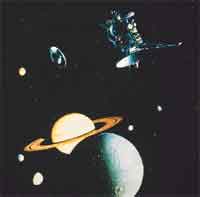Destination Saturn
Destination Saturn

the countdown for Cassini's launch had more than its share of the drama. For the first time in the history of space exploration, people protested against the launch of a spacecraft. Most of them were convinced that using plutonium to fuel the rockets attached to the probe was risky. Cassini carries 32.6 kg of plutonium-238 for propulsion. The chances of the nuclear fuel exploding were remote. But if the rockets failed and the spacecraft slipped back towards Earth, people argued, the canisters could crack open, releasing plutonium.
According to an estimate by John Gofman, former assistant director of Livermore Laboratory in California, the fine plutonium dust released in such an event would increase the risk of deaths due to cancer by a factor of 40,000 in 50 years. The protesters had a point. A few years ago, a us space shuttle had exploded soon after lift-off and there has been at least one space mishap involving fallout of radioactive debris (see box: Falling space debris ). As one protester put it: "I'm not anti-nuke, I'm not anti-space. I'm just anti-stupid, and I've got two kids.'
The fears were valid, but not justified, according to officials of the us National Aeronautics and Space Administration ( nasa ). Project officials calculated that the chances of the canisters cracking open were one in 1,400. In the worst-casescenario, they said that fallout of plutonium from burst canisters would be close to the launch site in Cape Canaveral, Florida. To allay fears, many officials brought their children and even grandchildren to watch the lift-off. But, as luck would have it, strong winds with speeds over 120 km per hour as much as 11 km up in the stratosphere delayed the launch. Cassini was finally launched 48 hours after its schedule, on October 15.
Long and winding route
Some 45 minutes of orbiting later, the rockets made a last surge, releasing the spacecraft on its voyage to Saturn. The swinging, looping,







